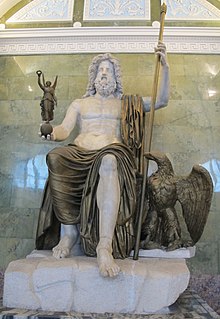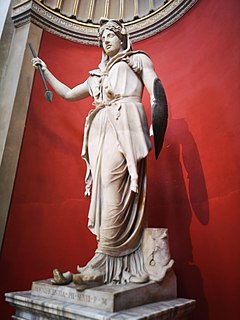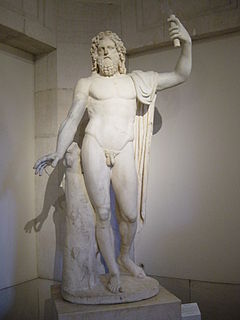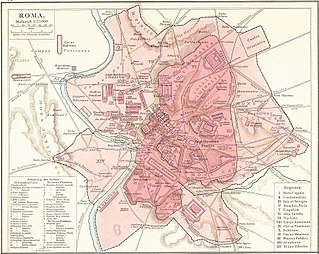Related Research Articles

Jupiter, also known as Jove, is the god of the sky and thunder and king of the gods in Ancient Roman religion and mythology. Jupiter was the chief deity of Roman state religion throughout the Republican and Imperial eras, until Christianity became the dominant religion of the Empire. In Roman mythology, he negotiates with Numa Pompilius, the second king of Rome, to establish principles of Roman religion such as offering, or sacrifice.

Vesta is the virgin goddess of the hearth, home, and family in Roman religion. She was rarely depicted in human form, and was often represented by the fire of her temple in the Forum Romanum. Entry to her temple was permitted only to her priestesses, the Vestals, who tended the sacred fire at the hearth in her temple. As she was considered a guardian of the Roman people, her festival, the Vestalia, was regarded as one of the most important Roman holidays. During the Vestalia matrons walked barefoot through the city to the sanctuary of the goddess, where they presented offerings of food. Such was Vesta's importance to Roman religion that hers was one of the last republican pagan cults still active following the rise of Christianity until it was forcibly disbanded by the Christian emperor Theodosius I in AD 391.

In Roman mythology, King Numitor of Alba Longa, was the maternal grandfather of Rome's founder and first king, Romulus, and his twin brother Remus. He was the son of Procas, descendant of Aeneas the Trojan, and father of the twins' mother, Rhea Silvia, and Lausus.

In ancient Roman religion, Dius Fidius was a god of oaths associated with Jupiter. His name was thought to be related to Fides.

Numa Pompilius was the legendary second king of Rome, succeeding Romulus after a one-year interregnum. He was of Sabine origin, and many of Rome's most important religious and political institutions are attributed to him, such as the Roman Calendar, Vestal Virgins, the cult of Mars, the cult of Jupiter, the cult of Romulus, and the office of Pontifex Maximus.

The Sabines were an Italic people that lived in the central Apennine Mountains of ancient Italy, also inhabiting Latium north of the Anio before the founding of Rome.

Festivals in ancient Rome were a very important part of Roman religious life during both the Republican and Imperial eras, and one of the primary features of the Roman calendar. Feriae were either public (publicae) or private (privatae). State holidays were celebrated by the Roman people and received public funding. Games (ludi), such as the Ludi Apollinares, were not technically feriae, but the days on which they were celebrated were dies festi, holidays in the modern sense of days off work. Although feriae were paid for by the state, ludi were often funded by wealthy individuals. Feriae privatae were holidays celebrated in honor of private individuals or by families. This article deals only with public holidays, including rites celebrated by the state priests of Rome at temples, as well as celebrations by neighborhoods, families, and friends held simultaneously throughout Rome.

The gens Fabia was one of the most ancient patrician families at Rome. The gens played a prominent part in history soon after the establishment of the Republic, and three brothers were invested with seven successive consulships, from 485 to 479 BC, thereby cementing the high repute of the family. Overall, the Fabii received 45 consulships during the Republic. The house derived its greatest lustre from the patriotic courage and tragic fate of the 306 Fabii in the Battle of the Cremera, 477 BC. But the Fabii were not distinguished as warriors alone; several members of the gens were also important in the history of Roman literature and the arts.

The Sibylline Books were a collection of oracular utterances, set out in Greek hexameters, that, according to tradition, were purchased from a sibyl by the last king of Rome, Tarquinius Superbus, and were consulted at momentous crises through the history of the Republic and the Empire. Only fragments have survived, the rest being lost or deliberately destroyed.

In Roman religion, Terminus was the god who protected boundary markers; his name was the Latin word for such a marker. Sacrifices were performed to sanctify each boundary stone, and landowners celebrated a festival called the "Terminalia" in Terminus' honor each year on February 23. The Temple of Jupiter Optimus Maximus on the Capitoline Hill was thought to have been built over a shrine to Terminus, and he was occasionally identified as an aspect of Jupiter under the name "Jupiter Terminalis".

Juno is an ancient Roman goddess, the protector and special counselor of the state. A daughter of Saturn, she is the wife of Jupiter and the mother of Mars, Vulcan, Bellona and Juventas. She is the Roman equivalent of Hera, queen of the gods in Greek mythology; like Hera, her sacred animal was the peacock. Her Etruscan counterpart was Uni, and she was said to also watch over the women of Rome. As the patron goddess of Rome and the Roman Empire, Juno was called Regina ("Queen") and was a member of the Capitoline Triad, centered on the Capitoline Hill in Rome; it consisted of her, Jupiter, and Minerva, goddess of wisdom.

The Rape of the Sabine Women, also known as the Abduction of the Sabine Women or the Kidnapping of the Sabine Women, was an incident in Roman mythology in which the men of Rome committed a mass abduction of young women from the other cities in the region. It has been a frequent subject of artists and sculptors, particularly during the Renaissance and post-Renaissance eras.

The Temple of Concord in the ancient city of Rome refers to a series of shrines or temples dedicated to the Roman goddess Concordia, and erected at the western end of the Roman Forum. The earliest temple is believed to have been vowed by Marcus Furius Camillus in 367 BC, but it may not have been built until 218 BC by L. Manlius. The temple was rebuilt in 121 BC, and again by the future emperor Tiberius between 7 BC and AD 10.
The gens Quinctilia, also written Quintilia, was a patrician family at Rome, dating from the earliest period of Roman history, and continuing well into imperial times. Despite its great antiquity, the gens never attained much historical importance. The only member who obtained the consulship under the Republic was Sextus Quinctilius Varus in 453 BC. The gens produced numerous praetors and other magistrates, but did not obtain the consulship again for over four hundred years.

Romulus was the legendary founder and first king of Rome. Various traditions attribute the establishment of many of Rome's oldest legal, political, religious, and social institutions to Romulus and his contemporaries. Although many of these traditions incorporate elements of folklore, and it is not clear to what extent a historical figure underlies the mythical Romulus, the events and institutions ascribed to him were central to the myths surrounding Rome's origins and cultural traditions.

A fetial was a type of priest in ancient Rome. They formed a collegium devoted to Jupiter as the patron of good faith.

The numerous epithets of Jupiter indicate the importance and variety of the god's cult in ancient Roman religion.
Caenina was a town nearby ancient Rome, in Latium.

In ancient Roman religion, a sacellum is a small shrine. The word is a diminutive from sacer. The numerous sacella of ancient Rome included both shrines maintained on private properties by families, and public shrines. A sacellum might be square or round.

The Temple of Juno Moneta was an ancient Roman temple that stood on the Arx or the citadel on the Capitoline Hill overlooking the Roman Forum. Located at the center of the city of Rome, it was next to the place where Roman coins were first minted, and probably stored the metal and coins involved in this process, thereby initiating the ancient practice of associating mints with temples. In addition, it was the place where the books of the magistrates were deposited.
References
- ↑ O Hehir, Brendan; Dillon, John M. A classical lexicon for Finnegans wake : a glossary of the Greek and Latin in the major works of Joyce, including Finnegans wake, the Poems, Dubliners, Stephen Hero, A portrait of the artist as a young man, Exiles, and Ulysses: APPENDIX A (PDF). University of California Press. pp. 606–07. ISBN 0-520-03082-6.
- ↑ Watmough (1995/96), p. 88.
- ↑ Cicero, Phil. 2.118.
- ↑ Dionysius of Halicarnassus 2.50; Livy 1.12.3–6; cf. [Cic.] Exil. 24; Ovid Fasti 6.794; Ovid Tristia 3.1.31–2; Livy 1.41.4; Appian BC 2.11; cf. Huskey (2006), pp. 19. 25.
- ↑ Livy, Ab urbe condita , 1.41
- ↑ Watmough (1995/96), p. 88.
- ↑ Livy, 1.12.5.